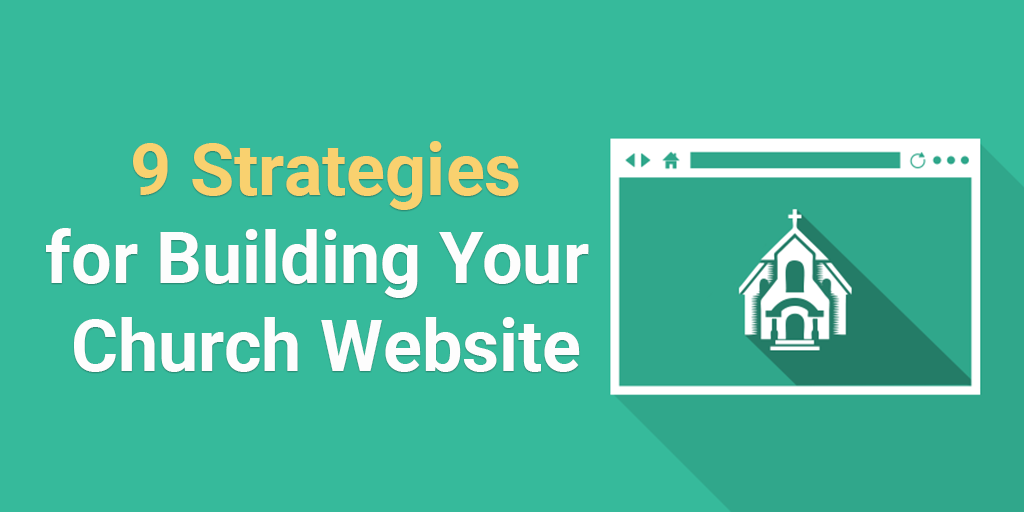
Your website shares a common purpose with your church: to communicate the saving message of the Gospel and to encourage potential visitors to step inside your church doors.
We want to help you create the best church website you can that helps further the mission of your church. Some of the following strategies are easier to implement than others, but all of them can be done, regardless of technical skill levels. We hope this post will give you some new ideas for your church website and help you improve your existing website in ways you might not have considered before.
1. Optimize Your URL
Your church website’s URL is your church’s digital address. It’s how people driving around cyberspace will drive right up to your front doors—no wrong turns and no frustrating detours. It’s important that your URL is easy to remember. Consider these strategies for creating a memorable URL:
Include the Full Name
One of the most common strategies is to use the church name and city as the URL. For example, Christ Community Church in Bakersville might use the domain www.christcommunitychurchbakersville.org. While a bit long, it is descriptive of the church, easy to remember, and most likely available for registration.
Keep It Short with Initials
In the example above, Christ Community Church may decide to shorten their URL to www.cccb.org. While this URL isn’t as identifiable to the church as the previous example, it is easy to remember and communicate to others. Again, the domain must be unique to your church and available for registration.
Use a Phrase
Some churches choose to use a welcoming phrase or a mission statement as their URL.
For example, Christ Community Church might choose to have their mission statement—Living Christ’s Love—as the URL: www.livingchristslove.org. While this looks great on publicity pieces, it could be hard to remember. “Was it www.livingchristslove.org or www.livechristslove.org?”
While your phrase might be clever or unique to your church, it might be hard for newcomers to remember whether your URL is for Christ Community Church or the church down the road.
2. Make Your URL Known
Once you have a great URL, share it! Put together a list of all the materials your church prints on a regular basis, and be sure you include the URL on the next printing. Here are just a few examples of where your URL should live.
Bulletins and Newsletters
By the time a visitor is reading your bulletin on Sunday morning, chances are pretty good they’ve already checked out your website. Remind them of where your church lives online so they can easily reference your website when they need to remember service times for next weekend.
Start directing members to the church website to find out more information about weekly announcements made in church. Say, “Visit ChristBakersville.org for more information on . . .” Seeing the URL in the bulletin and church newsletter will help your members and visitors become more familiar with the church website.
Outdoor Signs
Make sure your website address is clearly visible on your outdoor signage and that it’s easy to read from the road. If your sign is digital, keep your URL displayed somewhere on every screen.
To save space and draw attention to your URL, replace your church’s phone number on your outdoor signs with your URL. Hopefully, your URL is easier to remember than a phone number!
Flyers and Posters. Many churches still take advantage of community bulletin boards in grocery stores and restaurants. Whether you’re advertising a new Bible study or upcoming holiday services, always direct people to your website.
When announcing a special event, direct people to your website with a specific path added to your URL (e.g., ChristBakersville.org/Easter).
T-Shirts
Church T-shirts are quite common, especially during special events such as fundraisers and church picnics. Include your URL in the T-shirt design so people who see your shirt know where they can learn more about the church that made the awesome shirt!
Tell your congregation why you’re including the URL on the shirt—they may decide to wear it more just to get the word out.3. Utilize Your Members
The members of your congregation can be great resources for getting the word out about your church website, but you need to be intentional about asking them to do so.
Social Media
Ask your church members to follow you on your social media sites, and request that they share announcements or events that would interest potential visitors.
Studies show that social media users are much more likely to share a post when you specifically ask them (e.g., “Join us this Saturday morning for our annual Easter Egg Hunt! SHARE this post to invite your friends.”)
Other Websites
Some of your church members may own their own businesses or have personal blogs. Ask them to link to your church website through an image or simple callout.
Create a standard image that reads “Member of Christ Community Church” that features your church logo and links to your church website. This will make it easy for your members to point to your website, while giving it a consistent look across all referring sites.
Window Clings
Many churches give their members window clings with the church name or logo on it. Take advantage of this tactic by including your website URL.
Feedback Surveys
Keep your members engaged with the content that’s on your website, and ask them how they think it could be improved. Ask them what they like, what they don’t like, and what ideas they have. When people feel a sense of ownership related to the church website, they are much more likely to direct others to it.
Conduct your surveys online. In doing so, survey takers are already online, giving them easy access to your website for review as they complete the survey.
4. Keep It Simple
A great website is one with a great user experience. We asked, “What makes a great church website?” Phrases such as “easy to navigate” and “easy to find information” were quite common. So what makes a website “easy to use”? Check out these four tips for keeping your website simple:
Minimize Clicks
While clicking the mouse may not seem like much effort, having to do it too many times means that it delays the user from accessing the content they wish to see. Your website should have as flat of a site structure as possible, meaning the visitor should only have to click once or twice to get the information they desire.
Avoid Scrolling
Keep your pages short and to the point, with the most important information “above the fold,” a newspaper term used to mean at the top of the page. Page anchors, with a table of contents at the top, can help visitors easily jump to the most interesting content.
Minimize the Clutter
Less is often more. To create a clean, simple, and basic design, that might mean taking a look at your current content and deciding if you really need it all on your website. Maybe it doesn’t all have to be front and center. Prioritize your information based on what’s most important to your site visitors. Before adding anything, ask yourself, “Does this distract from the main point of the page?”
Limit Hover States
It can be a very frustrating experience when a user must hover over multiple items before being able to click on a link. If their hand is not steady, they’ll end up having to try again when the menu disappears. Navigation menus can still have drop-down menus, but make sure they support both hovering and clicking.
5. Create a Strong First Impression
Statistics show that more than 50 percent of your visitors will never go beyond your homepage. Consider these ideas for creating a homepage that will captivate your audience and encourage them to engage with your website.
Feature a Welcome Video.
Introduce your church in a 60-second or shorter video, and be sure to invite viewers to join you for worship at the end. A short welcome video is a great way to draw attention, introduce the pastor, and inform visitors about your church.
Add an “I’m New” Page
Have a specific page dedicated to visitors, and make sure it is clearly visible. If a user has to search for the information, they most likely won’t even try. Make it clear where they should go, and put all the important information front and center. Use second person voice when writing (e.g., “We would love to have you visit us” rather than “We love visitors.”). A slight shift in your writing style can make a big difference.
Display a Picture of Your Church
Whether your photos are of the outside or inside of your church, give visitors an immediate impression of your church. If you choose to show the inside of your church, try to capture a moment that represents your church on a normal Sunday (e.g., no seasonal decorations like Christmas trees or Easter lilies).
Keep Information Up-to-Date
A church website that is current and updated says that the church is alive and active. Whether you choose to post the latest sermon or link to the most recent newsletter, keep your content fresh and relevant.
6. Make Their First Visit Comfortable
By nature, people tend to avoid anything that makes them uncomfortable. Going to a new place where they know few or no people can be a nerve-racking experience. Alleviate any apprehension a visitor might have by making their visit to your website easy and inviting.
Display Information Clearly and Concisely
What are the service times? How long does a service last? Is there a Sunday School hour? Is one worship service more traditional than another? Do the men wear suits and ties, or are jeans the norm? Think about the questions you would have if you were to visit a new church, and make sure your website provides clear and concise answers so visitors can know what to expect.
Include video interviews of some of your newest members about their experiences at your church.
Clearly State What Your Church Believes
What your church preaches and believes should be explained in detail on your website. Many who are new to the faith are not yet sure what they believe, and this can serve as a teaching tool for them.
If applicable, visit your denomination’s website to see if they have resources available to help you develop this page.
Tell Visitors Where to Park
Point your visitors to the main entrance, especially if your church has multiple entrances. Show a picture of your church’s main entrance to give visitors a visual cue of where they should go.
Show an aerial view of your parking lot from an online map service to give people an idea of the lay of the land.
Take Visitors on a Virtual Tour
Many churches expand and add on to their building over the years. Take photos of important landmarks within the building to give visitors an idea of where they should go and what they’ll see. If your church is large, consider including a downloadable building map that visitors can print off and bring with them.
Include FAQs
Many people are afraid of doing the wrong thing—something that would draw unwanted attention to themselves during worship. Set minds at ease by explaining whether your worship is traditional or contemporary, what the service is like, the expected dress code, whether there’s a nursery, how long the services last, and so on.
7. Introduce Your Pastor
It’s important your website introduces your church leadership, especially your pastor. Consider including these three things about your pastor:
Invest in a Well-Written Biography
Give a short biography of the pastor; include where he studied and which previous congregations he has served. Include enough personal information while still respecting his privacy.
Consider including a picture of the pastor that represents the formality of your church. Is the pastor in robes every Sunday? Consider using a photo with the pastor in his collar. If your church is less formal, photograph him in business casual clothes.
Post Sermons Online
Let people get to know your pastor’s preaching style even through your website. Upload audio or video of your pastor’s sermons to give potential visitors an idea of how he preaches and what he teaches.
Upload every sermon so visitors can get a comprehensive idea of your pastor’s preaching style. Shy away from uploading a “best of” type of sermon archive. Give your visitors an idea of what every Sunday will be like.
Include an Invitation
Always include a welcome letter that is written specifically by the pastor with visitors in mind. Not all pastors are able to visit with every visitor at every service.
Update the letter regularly so that the pastor can highlight specific upcoming opportunities for fellowship.
8. Don’t Forget the Basics
In our survey, one response read: “The church website just needs to show the worship times and the church’s address; nothing else is really that important.” While showing only those two pieces of information might be too basic, this church worker brings up a great point: Make key information easy to find.
Church Name and Address
Sometimes, people use vague search terms when searching for a church (e.g., “local Lutheran church”). In doing so, they can stumble upon a website for a church that is in a completely different state. Make sure your website clearly states where your church is located. Someone in Louisiana isn’t necessarily interested in attending church in New Hampshire unless they’re on vacation. Include only your city and state in your page header and the whole address in the footer.
Worship Times
When a person is interested in visiting your church, don’t make it hard on them to figure out when your services start. Post your worship times visibly on the homepage, and make sure this information is only a click away from any other page.
Place “Join Us for Worship” at the top of your website that links to a page with the worship times listed.
Changes to the Calendar
Your online visitors expect your website to have the most current information—including any changes to the calendar or worship schedule. Changes in worship service times (e.g., special summer hours, combined worship times, holiday services), guest preachers, location changes (e.g., “Easter Worship in the Gym!”) should be clearly visible on your online calendar.
Put every change in a positive light. Rather than saying “Pastor Williams is on vacation this week, so Pastor Smith will be filling in,” post “We are blessed to have Pastor Smith as our guest preacher this weekend.”
9. Give a Clear Invitation
Church websites can be great at describing the church, but if they never invite online visitors to attend church, they lack the most important content. In the same way that it’s awkward to show up at an event uninvited, online visitors feel more comfortable walking inside your church when they are intentionally invited to do so.
We Invite You to Worship with Us
For new believers and those who do not believe, attending a worship service might be intimidating. Invite them to join you, and express your excitement that they’re worshiping with you.
See You at Bible Study!
Bible studies are a great time to interact with visitors and members on a personal level while you study God’s Word. Small groups are perfect for creating community and help newcomers and members connect with one another.
Prepare visitors for the study by giving them an overview of the topic, the style of teaching, and a list of what they should bring—a journal, a specific book or study guide, their Bible, etc.
Join Us for Fellowship.
Advertise fellowship opportunities, such as church-wide meals, picnics, or slow-pitch softball. Activities are a great way to encourage visitors to get connected and members to get more involved.
Change up the events regularly, but make sure they are no more than a month apart. If people have to wait too long, they’ll probably forget or lose interest.
Sign Up for a Service Project!
People love to serve because it allows them to put their skills to use and help God’s kingdom. Service projects are also low-pressure environments where people are in a more conversational than classroom environment.
Remember to Measure What Works and What Doesn't
Now that you’ve considered nine ways to improve or adjust your church website, the next step can be the most challenging: figure out what works best for your church. What works for one church may not work for another, and what content you thought would be unimportant may turn out to be the most important.
Measuring the effectiveness of your website may seem difficult, but there are many tools available that make this easier. One of the best tools, which also happens to be free, is Google Analytics (google.com/analytics).
Google Analytics can help you track how many people come to your website and where they came from. It shows you what they do once they arrive and where they are when they leave your website.
Some key measurements to track:
- Number of new website visitors versus returning visitors
- Traffic sources (e.g., Did your website visitors come from a Google search? From another website? From a blog?)
- Average time spent on each page
- Bounce rate by page (the percentage of visitors who leave)
- Highest traffic by time of the day and day of week
Using Google Analytics can help you measure the effectiveness of your website and highlight areas for improvement. It’s just one more way for you to know what your website visitors like and don’t like—and for you to use that knowledge to create a better user experience.
Start building your church website today with Church360° Unite!







